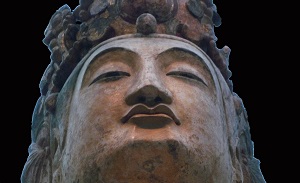Women Ancestors of Zen
 Although male teachers dominate the recorded history of Zen Buddhism, many remarkable women were part of Zen history also.
Although male teachers dominate the recorded history of Zen Buddhism, many remarkable women were part of Zen history also.
Some of these women appear in the koan collections. For example, Case 31 of the Mumonkan records an encounter between Master Chao-chou Ts'ung-shen (778-897) and a wise old woman whose name is not remembered.
A famous meeting took place between another old woman and Master Te-shan Hsuan-chien (781-867). Before becoming a Ch'an (Zen) master, Te-shan was famous for his scholarly commentaries on the Diamond Sutra. One day he found a woman selling rice cakes and tea. The woman had a question: "In the Diamond Sutra it is written that past mind cannot be grasped; the present mind cannot be grasped, and future mind cannot be grasped. Is that right?"
"Yes, that is right," said Te-shan.
"Then with which mind will you accept this tea?" she asked. Te-shan could not answer. Seeing his own ignorance, he found a teacher and eventually became a great teacher himself.
Here are five women who played vital roles in the early history of Zen Buddhism in China.
Zongchi (6th century)
Zongchi was the daughter of a Liang Dynasty emperor. She was ordained a nun at the age of 19 and eventually became a disciple of Bodhidharma, the First Patriarch of Zen. She was one of four dharma heirs of Bodhidharma, meaning that she completely understood his teachings. (A dharma heir is also a "Zen master," although that term is more common outside of Zen.)
Zongchi appears in a well-known story. One day Bodhidharma addressed his disciples, asking them what they had attained. Daofu said, “My present view is, without being attached to the written word or being detached from the written word, one still engages in the function of the Way.”
Bodhidharma said, “You have my skin.”
Then Zongchi said, “It’s like Ananda seeing the pure land of the Buddha Akshobhya. Seen once, it isn’t seen again.”
Bodhidharma said, “You have my flesh.”
Daoyu said, “The four elements are originally empty; the five aggregates are nonexistent. There’s not a single dharma to attain.”
Bodhidharma said, “You have my bones.”
Huike made three bows and stood still.
Bodhidharma said, “You have my marrow.”
Huike had the deepest understanding and would become the Second Patriarch.
Lingzhao (762-808)
Layman Pang (740–808) and his wife were both Zen adepts, and their daughter, Lingzhao, surpassed them both. Lingzhao and her father were very close and often studied together and debated each other. When Lingzhao was an adult, she and her father went on pilgrimages together.
There are a wealth of stories about Layman Pang and his family. In many of these stories, Lingzhao has the last word. A famous bit of dialogue is this:
Layman Pang said, “Difficult, difficult, difficult. Like trying to scatter ten measures of sesame seed all over a tree.”
Hearing this, the layman's wife said, “Easy, easy, easy. Just like touching your feet to the ground when you get out of bed.”
Lingzhao responded, “Neither difficult nor easy. On the hundred grass tips, the ancestors' meaning.”
According to legend, one day when Layman Pang was very old, he announced he was ready to die when the sun had reached its height. He bathed, put on a clean robe, and lay on his sleeping mat. Lingzhao announced to him the sun was covered -- there was an eclipse. The layman stepped outside to see, and while he watched the eclipse, Lingzhao took his place on the sleeping mat and died. When Layman Pang found his daughter, he sighed, "She has beaten me once more."
Liu Tiemo (ca. 780-859), the "Iron Grindstone"
"Iron Grindstone" Liu was a peasant girl who became a formidable debater. She was called the "Iron Grindstone" because she ground her challengers to bits. Liu Tiemo was one of 43 dharma heirs of Guishan Lingyou, who was said to have 1,500 disciples.
Moshan Liaoran (ca. 800s)
Moshan Liaoran was a Ch'an (Zen) master and teacher and the abbess of a monastery. Both men and women came to her for teaching. She is the first woman thought to have transmitted the dharma to one of the male ancestors, Guanzhi Zhixian (d. 895). Guanzhi was also a dharma heir of Linji Yixuan (d. 867), founder of the Linji (Rinzai) school.
After Guanzhi became a teacher, he told his monks,
“I got half a ladle at Papa Linji’s place, and I got half a ladle at Mama Moshan’s place, which together made a full ladle. Since that time, after having fully digested this, I’ve been satisfied to the full.”
Miaoxin (840-895)
Miaoxin was a disciple of Yangshan Huiji. Yangshan was a dharma heir of Guishan Lingyou, the teacher of "Iron Grindstone" Liu. This perhaps gave Yangshan an appreciation of strong women. Like Liu, Miaoxin was a formidable debater. Yangshan held Miaoxin in such high regard he made her minister of secular affairs for his monastery. He said,
"She has the determination of a person of great resolve. She is truly the one qualified to serve as the director of the office for secular affairs."
By Barbara O'Brien
Suorce: learnreligions.com/

